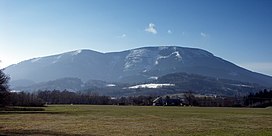geo.wikisort.org - Mountains
The Moravian-Silesian Beskids (Czech: ![]() Moravskoslezské Beskydy, Slovak: Moravsko-sliezske Beskydy) is a mountain range in the Czech Republic with a small part reaching to Slovakia. It lies on the historical division between Moravia and Silesia, hence the name. It is part of the Western Beskids within the Outer Western Carpathians.
Moravskoslezské Beskydy, Slovak: Moravsko-sliezske Beskydy) is a mountain range in the Czech Republic with a small part reaching to Slovakia. It lies on the historical division between Moravia and Silesia, hence the name. It is part of the Western Beskids within the Outer Western Carpathians.
This article includes a list of references, related reading or external links, but its sources remain unclear because it lacks inline citations. (August 2014) |
| Moravian-Silesian Beskids | |
|---|---|
 Smrk mountain in early spring | |
| Highest point | |
| Peak | Lysá hora |
| Elevation | 1,323 m (4,341 ft) |
| Coordinates | 49°32′45″N 18°26′51″E |
| Naming | |
| Native name | Moravskoslezské Beskydy (Czech) |
| Geography | |
 Moravian-Silesian Beskids | |
| Countries | Czech Republic and Slovakia |
| Regions | Moravian-Silesian, Czech Republic and Žilina, Slovakia |
| Parent range | Western Beskids |
| Geology | |
| Orogeny | Alpine |
| Age of rock | Miocene |
| Type of rock | Godulian sandstone |
Geography
The mountains were created during the Alpine Orogeny in the Cenozoic. Geologically, they consist mainly of flysch deposits. In the north, they steeply rise nearly 1,000 m (3,300 ft) over a rather flat landscape; in the south, they slowly merge with the Javorníky. In the south-west, they are separated from the Vsetínské vrchy by the Rožnovská Bečva valley; in the north-east, the Jablunkov Pass separates them from the Silesian Beskids.

The highest point is Lysá hora mountain at 1,323 m (4,341 ft), which is one of the rainiest places in the Czech Republic with around 1,500 mm (59 in) of precipitation a year. Many legends are bound to Radhošť Mountain, 1,129 m (3,704 ft), which is one of the most visited places in the mountains together with the nearby Pustevny resort.
Smrk, with a height of 1,276 m (4,186 ft), is the second highest summit of the range. Its northern slope steeply rises from the surrounding lowlands and is separated from the rest of the mountains by the deep Ostravice River (in the east) and Čeladenka (in the west) river valleys; in the south, it merges in the lower Zadní hory (i.e. Rear mountains) area.
The Moravian-Silesian Beskids create the largest part of the Beskydy Landscape Protected Area. The mountains are 80% forested, though mainly by plantations of spruce which were in some parts severely damaged by emissions from the Ostrava industrial region. Originally, the mountains were covered by mixed forest with dominant beech which are preserved in many places. Recently, permanent occurrence of all three large Central European carnivores – lynx, bear and wolf – have been confirmed in the area.

There are many popular holiday resorts for both winter and summer activities, with centers in the towns under the mountains (Frýdlant nad Ostravicí, Frenštát pod Radhoštěm, Rožnov pod Radhoštěm) and also in smaller resorts, hamlets and chalets throughout the mountains, especially on the ridges. Parts of two euroregions, the Beskydy/Beskidy and Těšínské Slezsko/Śląsk Cieszyński, reach into the Moravian-Silesian Beskids.
References
- Ludvík, Marcel (1987). Beskydy, Turistický průvodce ČSSR. Prague: Olympia. 27-031-87.
- Rohlík, Jiří (2001). Moravskoslezské Beskydy, Soubor turistických map 1:50 000. Praha: TRASA, s.r.o. ISBN 80-85999-29-3.
- CHKO Beskydy Management. "CHKO Beskydy". Retrieved 2007-05-05.
На других языках
[de] Mährisch-Schlesische Beskiden
Die Mährisch-Schlesischen Beskiden (tschechisch Moravskoslezské Beskydy; slowakisch Moravsko-sliezske Beskydy) sind ein Gebirgszug der Westbeskiden im Osten Tschechiens. Ein kleiner Teil der Mährisch-Schlesischen Beskiden ragt in den Norden der Slowakei hinein.- [en] Moravian-Silesian Beskids
[fr] Beskides moravo-silésiennes
Les Beskides moravo-silésiennes sont un massif montagneux de République tchèque avec une petite partie en Slovaquie. Elles se trouvent dans les Beskides dans les Carpates occidentales. Elles sont de part et d'autre de la frontière historique entre la Silésie et la Moravie.[it] Beschidi Moravo-Slesiani
I Beschidi Moravo-Slesiani (in ceco Moravskoslezské Beskydy) sono un massiccio montuoso al confine tra Slovacchia e Repubblica Ceca, parte della catena dei Monti Beschidi.[ru] Моравско-Силезские Бескиды
Мора́вско-Силе́зские Бески́ды (словацк. Moravskosliezske Beskydy, чеш. Moravskoslezské Beskydy, польск. Beskid Śląsko-Morawski, сил. Ślůnsko-Morawski Beskid) — горный массив в северо-западной Словакии, северо-восточной Чехии и южной Польше, часть Западных Бескид. Наивысшая точка — Лыса Гора, 1324 м в чешской Силезии.Другой контент может иметь иную лицензию. Перед использованием материалов сайта WikiSort.org внимательно изучите правила лицензирования конкретных элементов наполнения сайта.
WikiSort.org - проект по пересортировке и дополнению контента Википедии
